Whether you’re looking for an adventure or you’re interested in learning about new places, come virtually travel to some of the most exotic dive sites around the world.
Europe
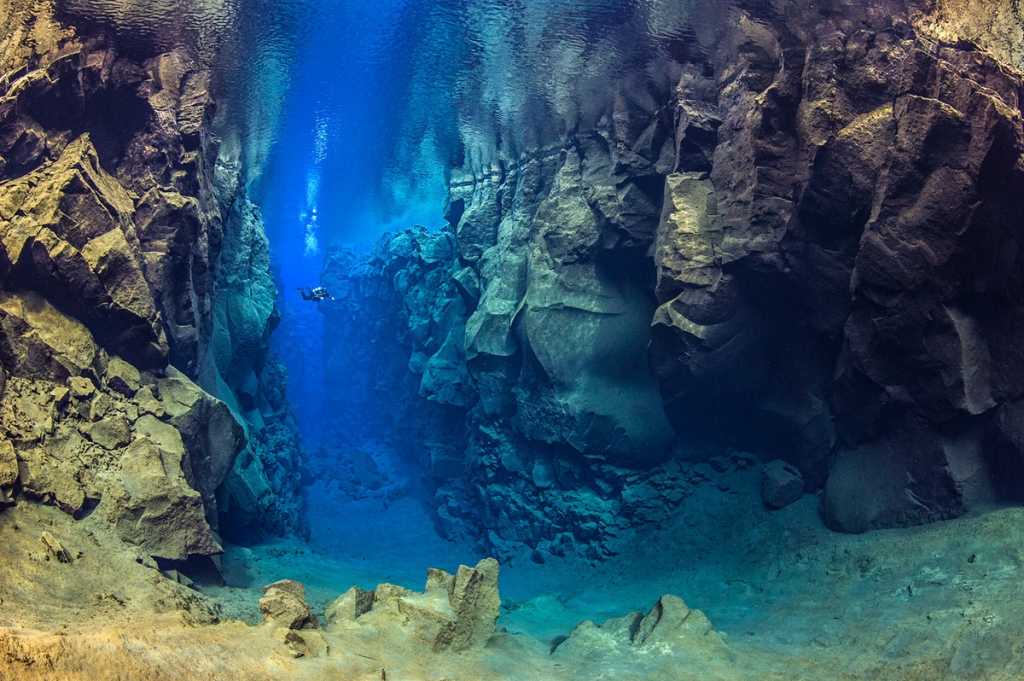
Iceland: Thingvellir
Only those daring enough to jump into extreme temperatures get the chance of a lifetime to touch two continents at the same time. Explore between the North American and Eurasian tectonic plates in Thingvellir National Park. Although there’s a lack of marine life, the crystal clear waters allow you to see hundreds of feet around you providing divers with a stunning view of the channel walls. A UNESCO World Heritage site, this is the only place in the world where you can dive between continental plates.
Avg. Water Temp: 37ºF (2.8ºC)
Avg. Visibility: 330 ft (101 m)
Avg. Depth: 33-60 ft (10-18 m)
Image from Iceland Naturally
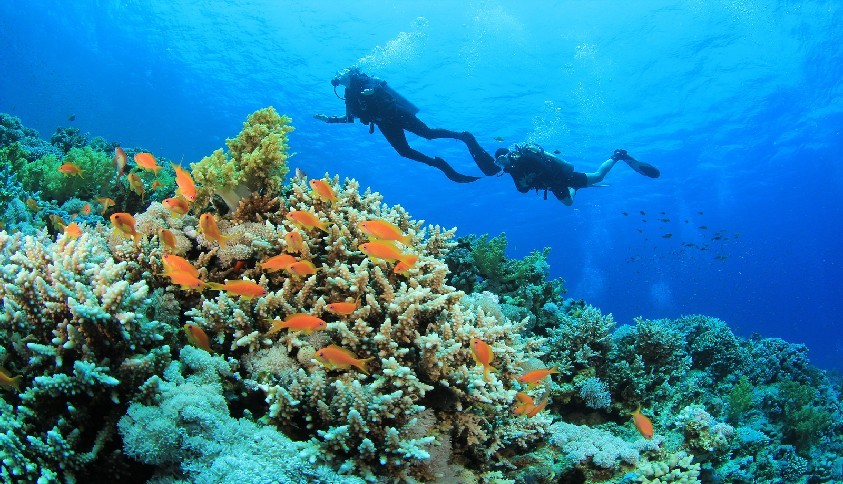
Greece: Chios Island
The Chios Island dive is made up of wrecks dating as far back as 350 B.C. to unbelievable rock formations like the Great Wall (100 ft. vertical wall). Underrated and overlooked the dive is extraordinary for beginners as it is simple and has a lot of exploring. Discover Greece through the eyes of the ocean and uncover some of its ancient treasures.
Avg. Water Temp: 70ºF (21ºC)
Avg. Visibility: 20-165 ft (6-50 m)
Avg. Depth: 100 ft (30 m)
Image from Antelope Travel
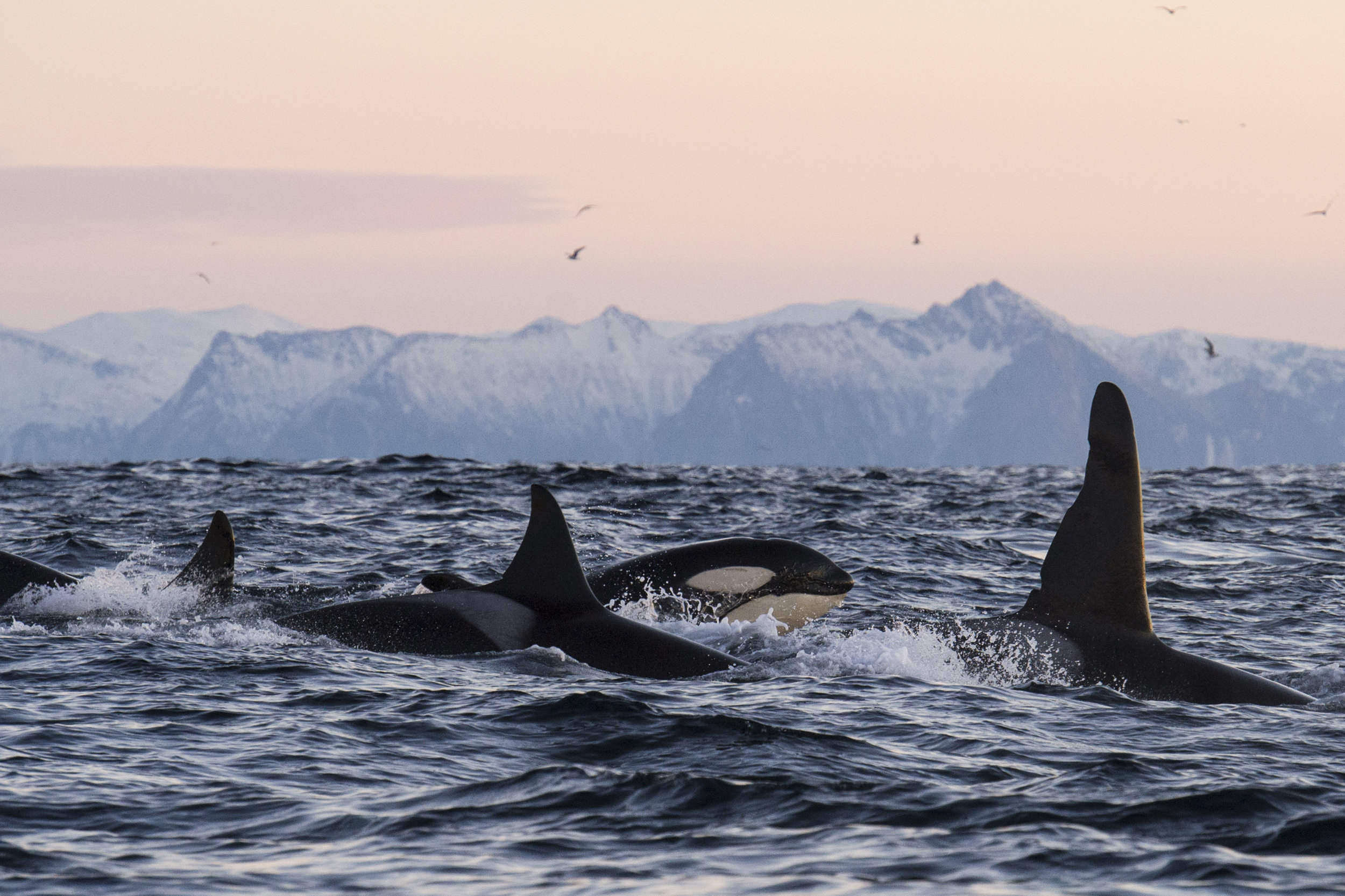
Norway: Lofoten Islands
Although this dive is snorkel and free dive only, you can get the experience of a lifetime as you submerge yourself into the cold Norwegian waters. The Lofoten Island dives give you the chance to swim in the Norwegian Sea where crowds of Orcas power through the water.
Orcas are very powerful beings and can grow up to 32 feet long. This makes them apex predators which means they have no natural predators. With their intelligence and teammwork, Orcas easily conquer the waters they swim in. Despite being known to attack for no reason, Orcas can be friendly and we have only done them harm by taking them from their homes, simply for our recreation and entertainment. Watching them live in their natural habitats is a sight to see.
Avg. Water Temp: 36ºF (2.2ºC)
Avg. Visibility: 50 ft (15 m)
Avg. Depth: 65-130 ft (19.8-39.6 m)
Image from Dance With Whales
Asia
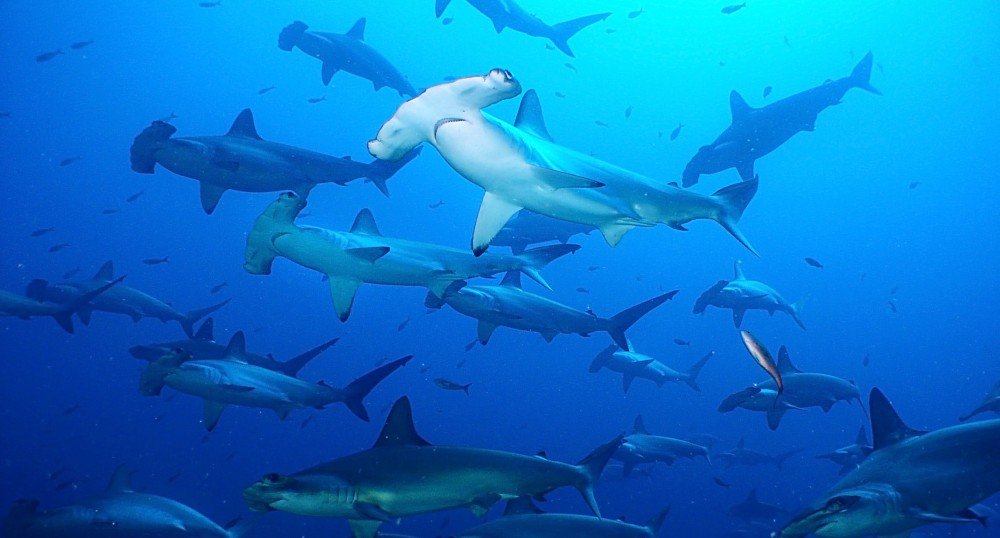
Maldives: Ari Atoll
A collection of 105 islands, Ari Atoll provides divers with the opportunity to dive next to some of the larger species of the ocean including whale sharks, manta rays, and hammerheads while exploring around a submerged mountain range. Due to the size of the Ari Atoll protected area, you can find dives for all skill levels but be aware that most areas have strong currents and unpredictable conditions because of the lack of walls and reefs.
Avg. Water Temp: 81ºF (27ºC)
Avg. Visibility: 75 ft (22.9 m)
Avg. Depth: 100-130 ft (30-39.6 m)
Image from Maldives Boat Club
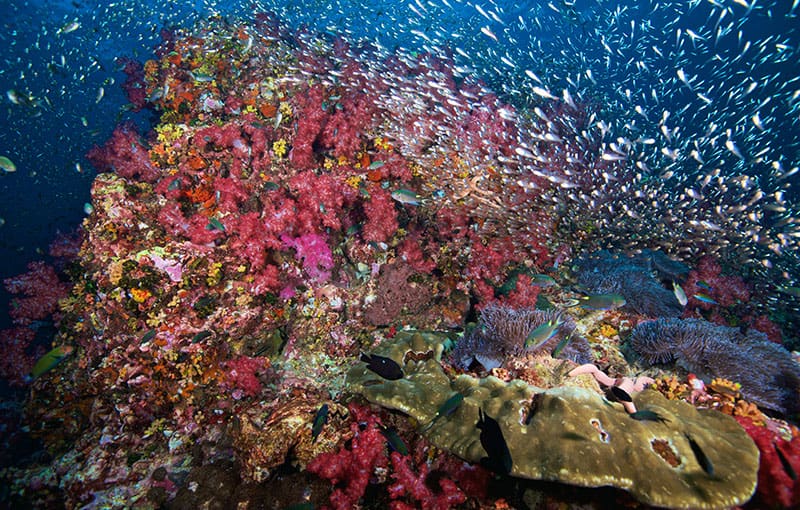
Thailand: Richelieu Rock
Richelieu Rock is one of the best dives sites in Asia and Thailand. The rock itself is not enormous but the dive site is very large so it is recommended to stay overnight on a boat to be able to get the best experience. Swarming with life, colors and treasures hidden in the soft corals, once you’re in the water you’ll want to stay the night. You can see weird species like the harlequin shrimp and the ghost pipefish, to the more common rays, barracuda, and whale sharks. Don’t forget to try to spot the rare tomato clownfish and octopus that blend in perfectly with their environment. Take your time here, it’ll be worth it.
Avg. Water Temp: 81ºF (27ºC)
Avg. Visibility: 49-115 ft (15-35 m)
Avg. Depth: 16-115 ft (4.9-35 m)
Image from MV Giamani
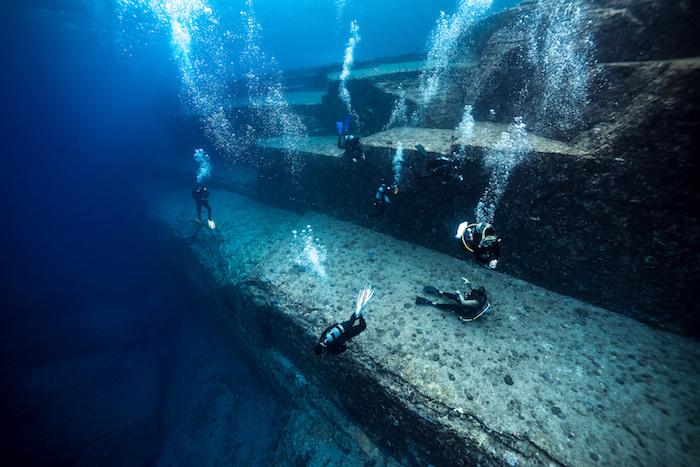
Japan: Yonaguni Jima
The Yonaguni Jima is a very unique dive because just 15 feet below the ocean’s surface there are giant, mysterious structures laying there. No one knows where they came from or how they got there. Some say it could be like Atlantis, where this was once a civilization that was consumed as the oceans rose years ago or collapsed due to an earthquake while others say it could be some sort of natural occurrence. With the 180 ft visibility almost year round, there is so much you can see despite the large structures taking up most of the dive site’s space. If you ever get a chance to dive here, take a go at the structure, see if you can discover anything about these strange formation.
Avg. Water Temp: 79ºF (26ºC)
Avg. Visibility: 180 ft (55 m)
Avg. Depth: 18 ft (5.5 m)
Image from Japan Info
Indonesia: Liberty Wreck
Liberty wreck is the dive site of the U.S.A.T. Liberty which was a United States Army cargo ship used during WW1 and WW2. The 400 foot long ship was torpedoed by a Japanese submarine in January of 1942 where it then crashed onto the island of Bali in Indonesia. A volcanic erruption on the island later on caused the ship to be carried into the ocean where it has become a home for many plants and animals over the years. It is now a famous dive site for divers of all levels and specialties. This dive provides you with both history and ocean life as you can visit the ship and explore the corals, fish, and sharks that inhabit this protected area.
Avg. Water Temp: 75ºF (23.9ºC)
Avg. Visibility: 30-100 ft (9-30 m)
Avg. Depth: 60-100 ft (18-30 m)
Image from Japan Info
Oceania
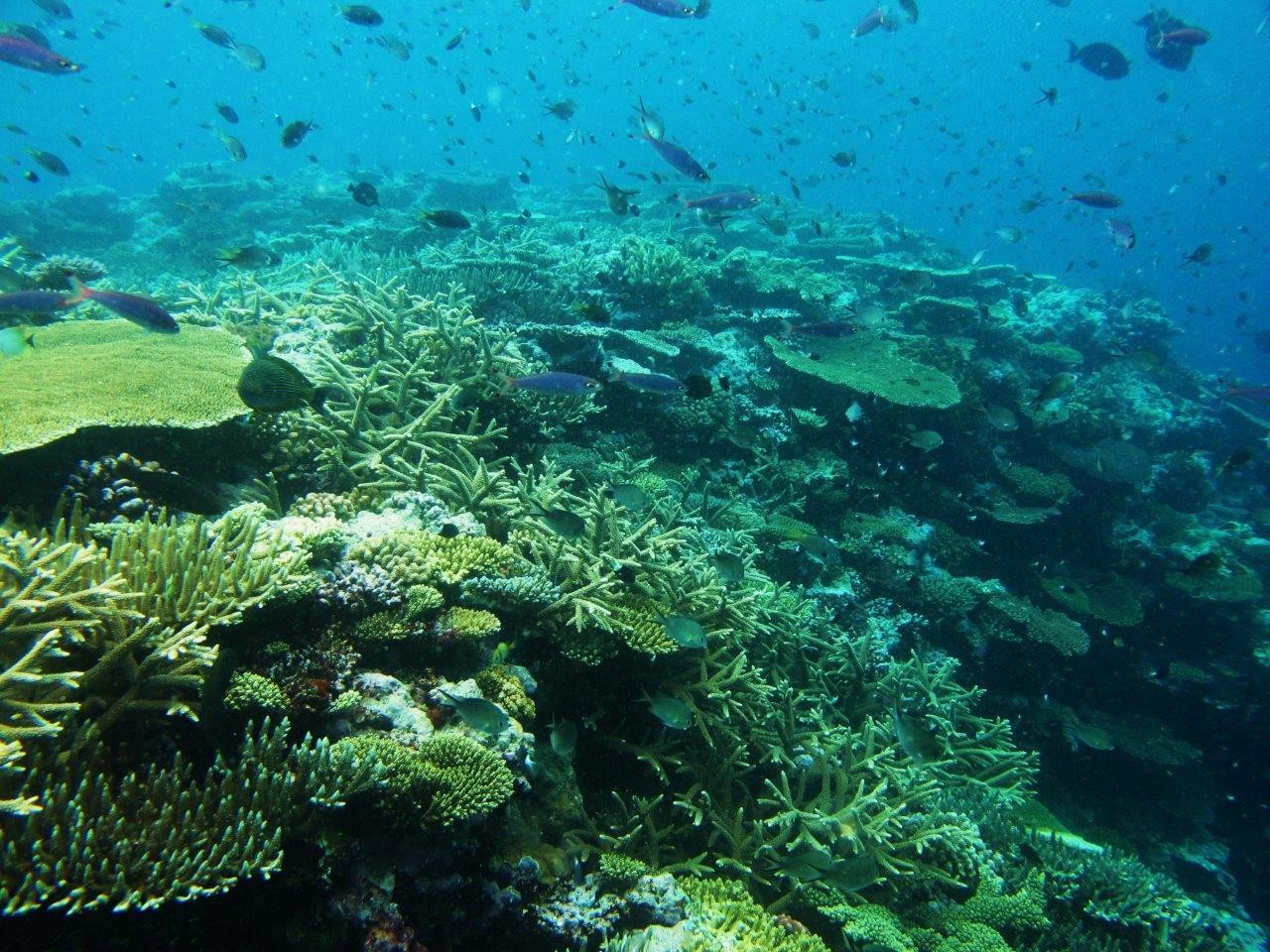
New Caledonia: Cathedral
Located about 750 miles northeast of Brisbane, Australia, here you’ll find 990 miles of barrier reef surrounding one of the world’s largest lagoons. There are 350 species of corals, 1,600 species of fish, as well as dugongs and sea turtles. A UNESCO World Heritage site, divers can explore shallow lagoons, night dives, reef dives, and open water dives. Species you might encounter during your dive include manta and eagle rays, seahorses, sharks, corals and more!
Avg. Water Temp: 75ºF (24ºC)
Avg. Visibility: 66 ft (20 m)
Avg. Depth: 80 ft (24 m)
Image from Triploo
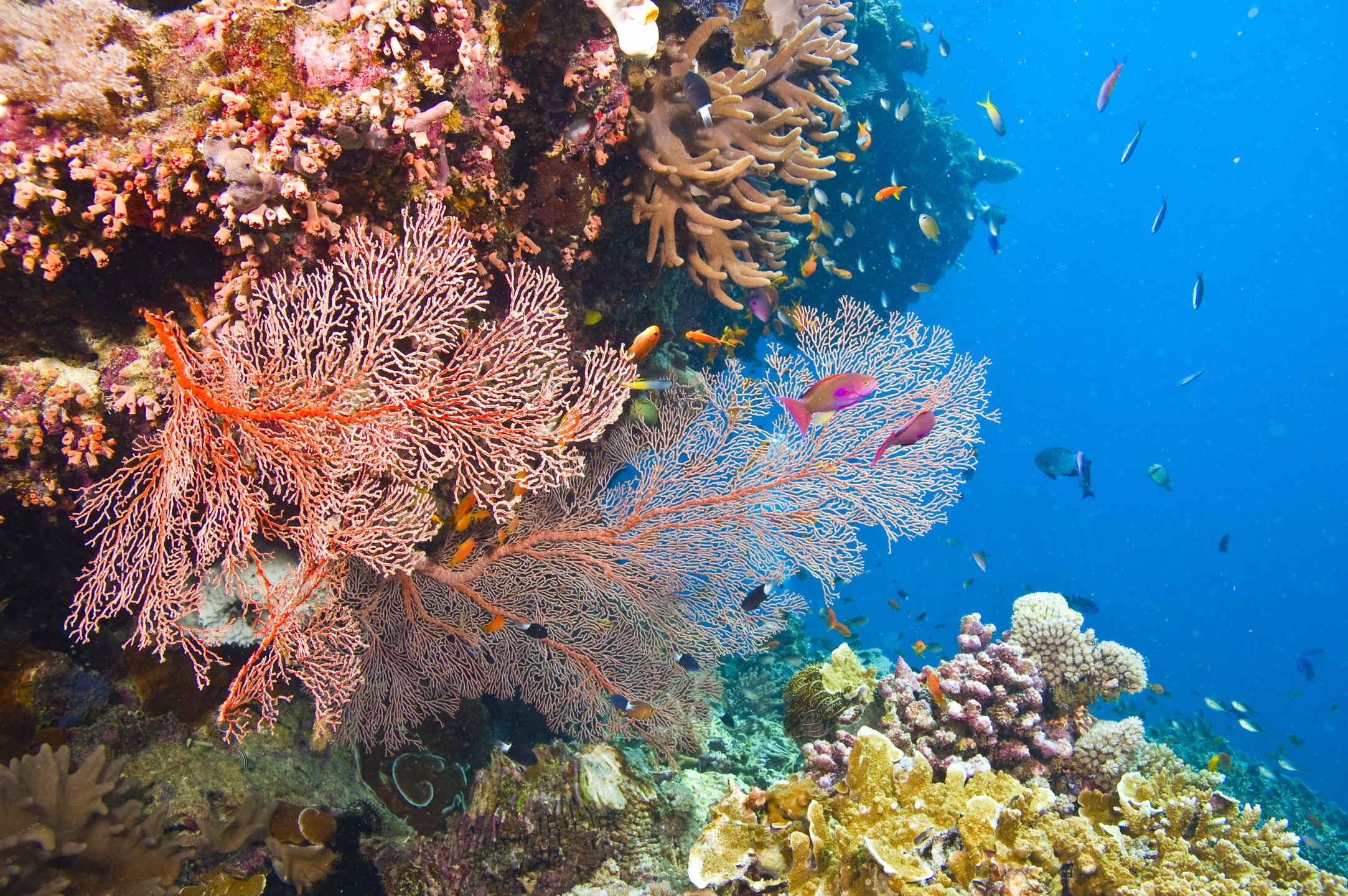
Australia: Cocos (Keeling) Islands
Home to 500 species of fish, 600 species of mollusks, 200 species of crustaceans, and 100 species of hard corals, the islands with their white sandy beaches make up a paradise in the middle of the Indian Ocean. Made for beginners this site includes shore, reef, wreck, and drift dives. Explore the lagoons, the shallow reefs, and the ocean swarming with life. During your dive you may encounter turtles, dolphins, manta rays, sharks, and Kat the dugong.
Avg. Water Temp: 82ºF (27.8ºC)
Avg. Visibility: 66-100 ft (20-30.5 m)
Avg. Depth: 30-130+ ft (9-39.6+ m)
Image from Culture Trip
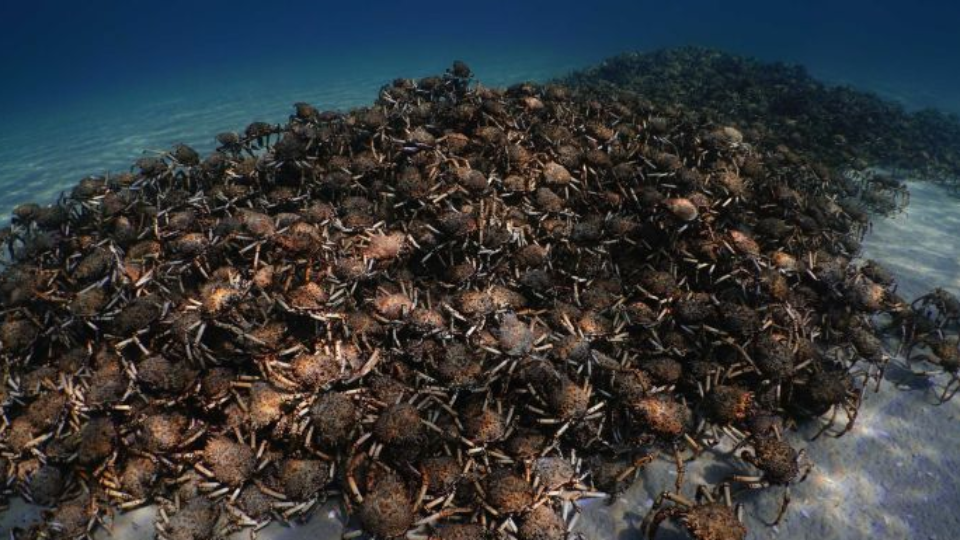
Australia: Port Phillip Bay
A fun dive for beginners, Port Phillip Bay provides the opportunity to dive in kelp forests, wrecks, and gardens of different seaweed and sea grass species. Explore Octopus’s Garden, Flinders Pier, The Pope’s Eye, and more entertaining dive sites nearby for all dive levels. Famous for it’s hundreds of giant spider crabs that cover the sea floor, you can also see seahorses, sea stars, octopus, and many species of fish during your dive.
Avg. Water Temp: 65ºF (18ºC)
Avg. Visibility: 50 ft (15 m)
Avg. Depth: 40-130 ft (12-39.6 m)
Image from The New Daily
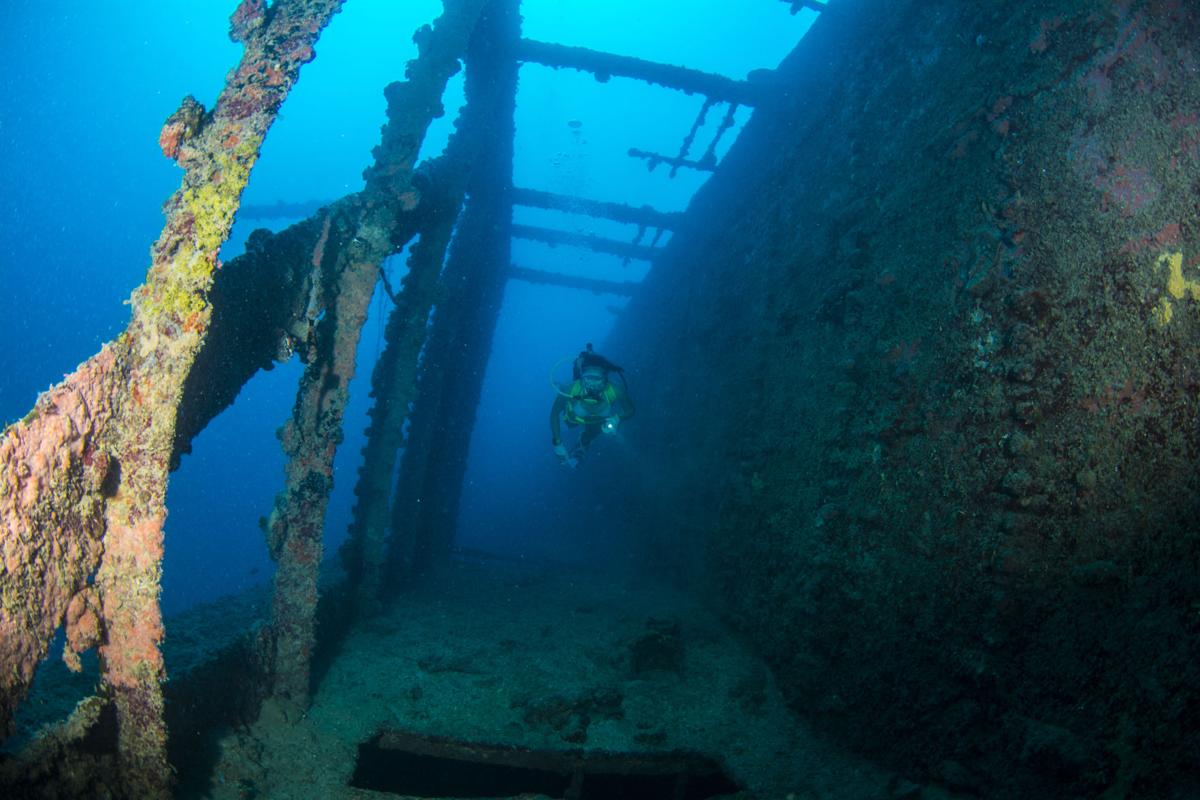
Guam: Tokai Maru & S.M.S. Cormoran
Go back in time to explore the Japanese Tokai Maru a passenger cargo ship used during WWII and the S.M.S Cormoran a German ship built for the Russians during WWI. These ships are only a few feet apart under the surface of Guam’s deep blue water, making this site one of the only places in the world where you can experience both wars in one dive. Swim a little further and you’ll be able to see the American tanker than has become a reef for thousands of species of marine life.
Avg. Water Temp: 84ºF (29ºC)
Avg. Visibility: 50 ft (15 m)
Avg. Depth: 50-100 ft (15-30 m)
Image from The Guam Daily Post
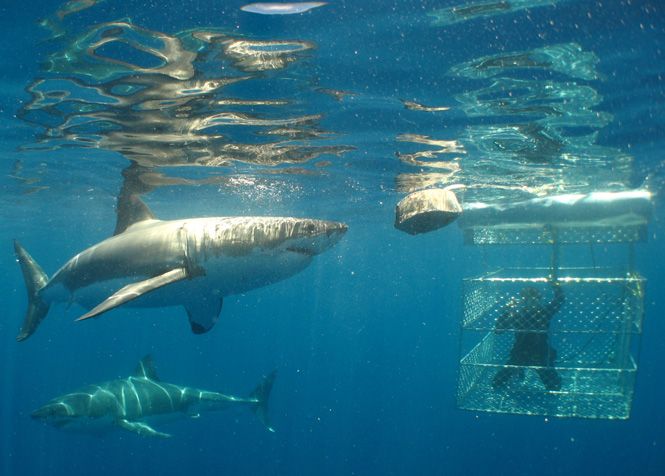
Australia: Port Lincoln
Port Lincoln is cage diving only due to the great white sharks roaming around the area. There are surface cage dives for anyone interested in getting wet and looking for the giants that blend in with the big blue ocean, and for certified divers there’s an 80 ft cage dive straight down into shark territory. But don’t worry, either way it is safe because great whites don’t actually act the way they do in movies. They’re actually very calm below the surface. The dive site is highly protected with many rules and regulations to protect these peaceful giants and other species that pass through. As long as you are calm and respectful the sharks will be harmless and you can enjoy a worriless dive.
Avg. Water Temp: 63ºF (17ºC)
Avg. Visibility: 33 ft (10 m)
Avg. Depth: 82 ft (25 m)
Image from Pinterest
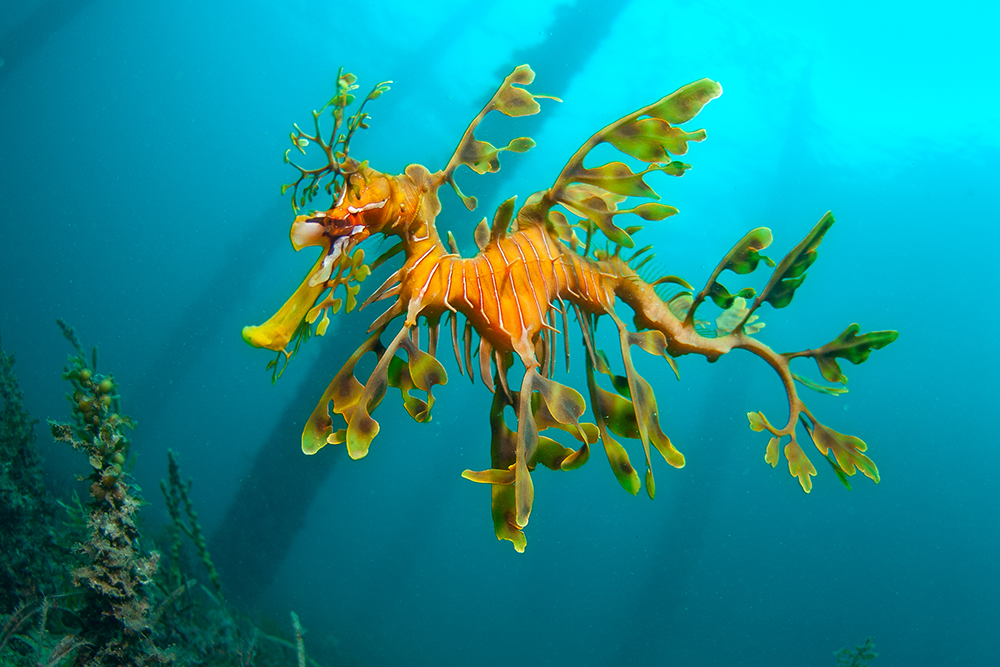
South Australia: Rapid Bay Jetty
Rapid Bay Jetty is known for one thing, the leafy seadragon. Found only in Australia, the leafy seadragon is one of the ocean’s many unique creatures. They blend in perfectly with seaweed and kelp as they float around with the currents, swaying side to side just like the plants. The leafy seadragon is a near threatened species but is still very protected because for a long time divers would capture them to take them as pets. Please do not do this. Approach them with care and be patient because they get scared quite easily. During this dive you’ll be navigating around a jetty that is filled with fish and plants. It’s a perfect place to take pictures.
Avg. Water Temp: 62ºF (16.7ºC)
Avg. Visibility: 15-50 ft (4.6-15 m)
Avg. Depth: 22-40 ft (6.7-12 m)
Image from Australian Geographic
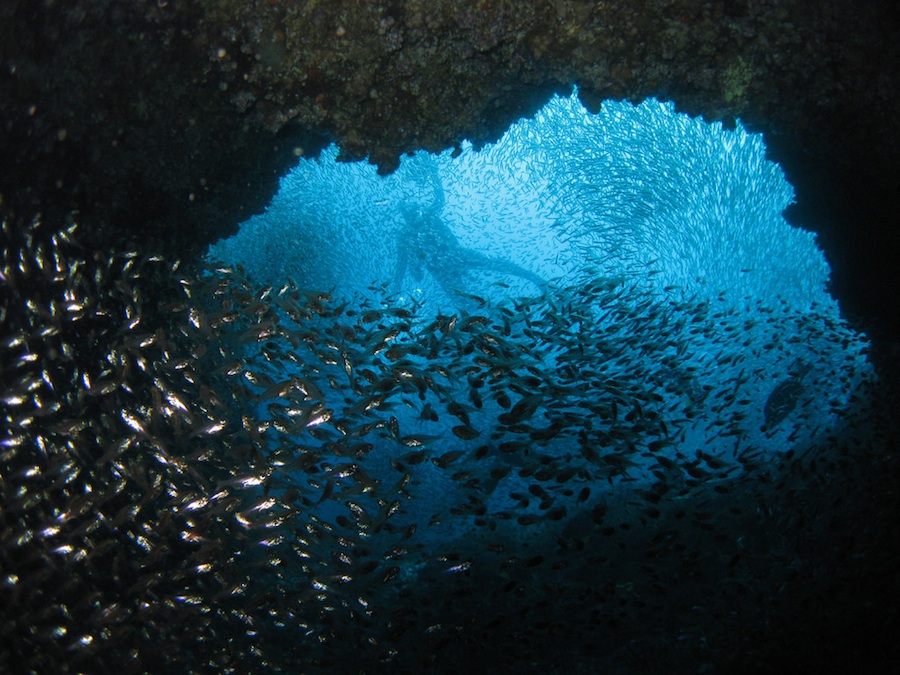
Australia: Julian Rocks
Julian Rocks is a large group of granite rocks, born from a volcano, that is located about a mile away from Byron Bay, Australia. It is a protected marine reserve consisting of natural caves, walls, and underwater structures, as well as thousands of different species of marine life. From rays and sharks to fish and turtles, you can see an unimaginable diversity in the water year round as species pass through during the migratory seasons. The friendly currents, good visibility, and diversity in marine life make this one of the world’s best places for beginners.
Avg. Water Temp: 71ºF (21.7ºC)
Avg. Visibility: 16-100 ft (4.9-30 m)
Avg. Depth: 78 ft (23.8 m)
Image from Verandah Magazine
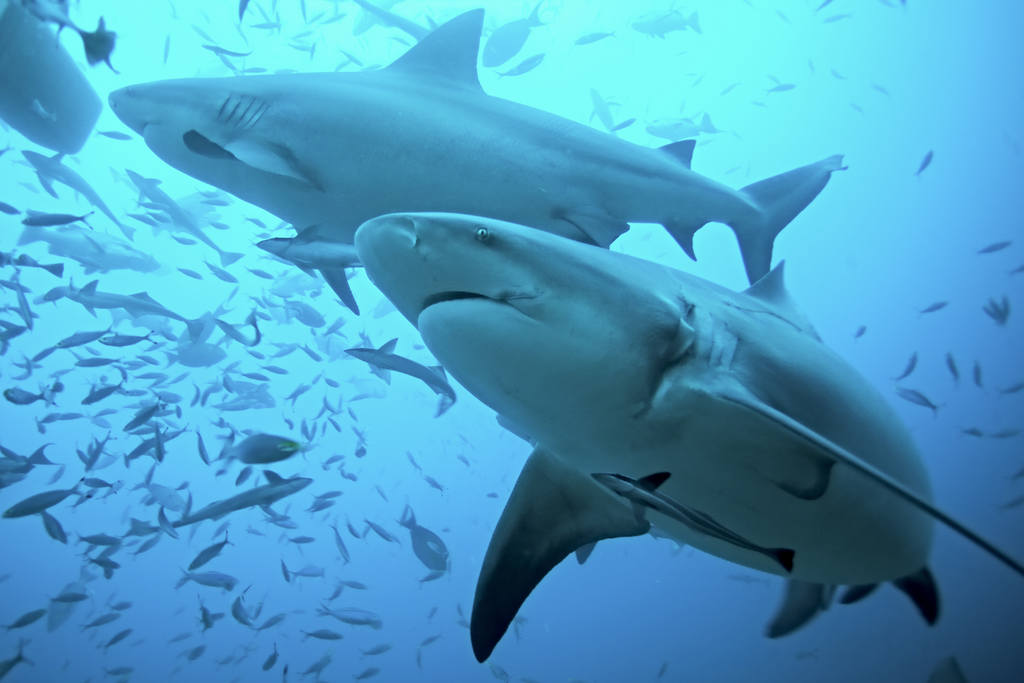
Fiji: Beqa Lagoon
Located near one of Fiji’s 332 islands, Beqa Lagoon is a memerizing, unique, diverse, and colorful dive. Known for its soft coral reefs and sharks, the dive offers exploration and discovery like you’ve never experienced before. The locals have learnt to coeexist with the native shark species in order to keep tourism safe for divers and sharks alike. As you descend into the depths of the lagoon, the local handlers help keep a safe distance between you and the sharks that roam the clear blue waters. The dives here are meant to promote conservation of sharks and the organisms of the ocean as well as educate people about sharks. Too many people believe that sharks are killers, like movies portray them to be, but they are not. They want to live their lives, safely and undisturbed. As long as you leave them alone, they’ll leave you alone.
Avg. Water Temp: 78ºF (25.6ºC)
Avg. Visibility: 60 ft (18 m)
Avg. Depth: 80 ft (24 m)
Image from Dive O’Clock
North America
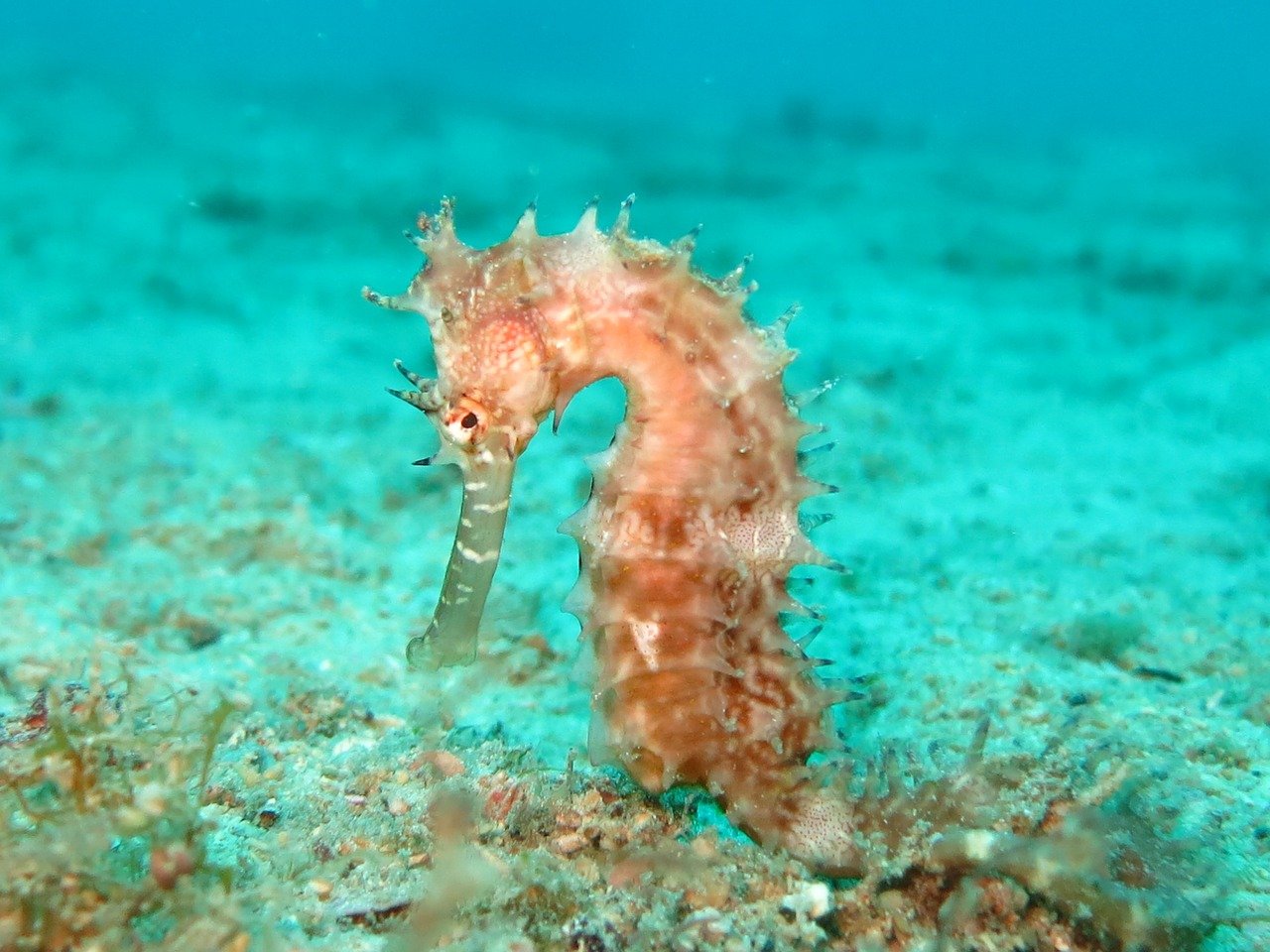
St. Vincent and the Grenadines: Critter Corner
Love getting up close and personal with the cute little creatures? Or photographing sea life? This is the place for you. Critter corner is a clear dive filled with hundreds of fascinating little guys like shrimp, seahorses, pipefish, and more. If during your dive you think you’ve seen every critter there, you can also visit nearby sites like Orca Point, Anchor Reef, and New Guinea Reef. Other creatures you may find include multiple species of eels, octopuses, lobsters, and yellowface pike blennies (only 8.5 cm long).
Avg. Water Temp: 80ºF (26.7ºC)
Avg. Visibility: 25-150 ft (7.6-45.7 m)
Avg. Depth: 32 ft (9.7 m)
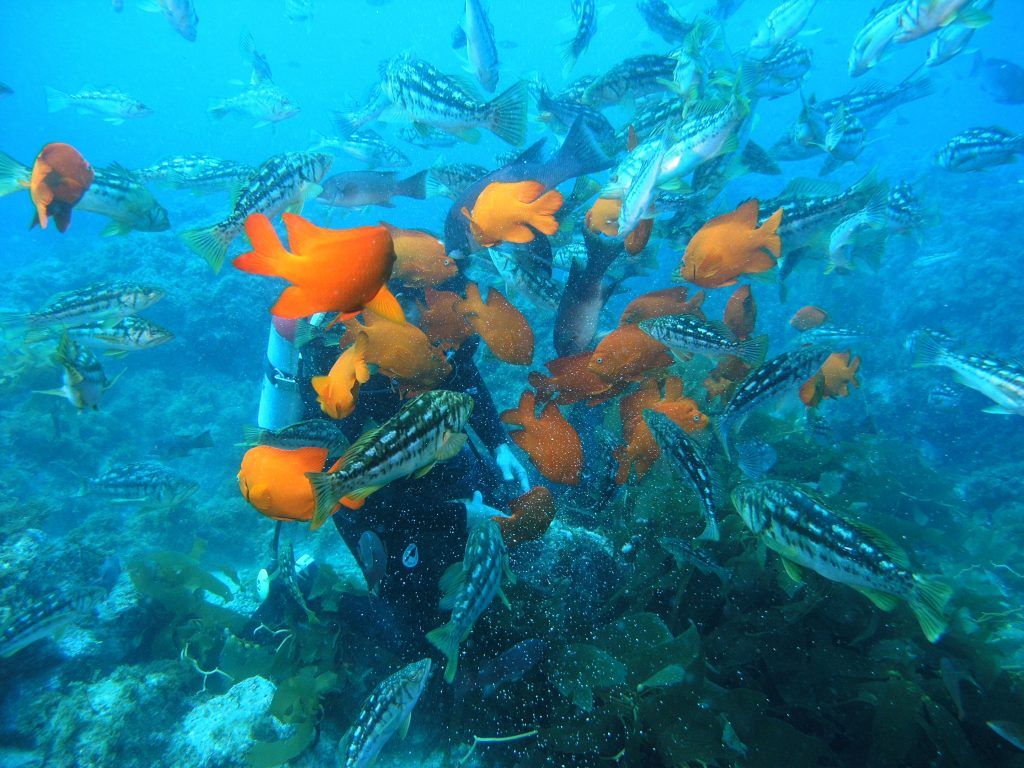
California: Santa Catalina Island
If you’re planning to dive in California you may need to stay a couple days. Catalina Island alone has over 70 different dive sites, filled with hundreds of different species. From kelp forests to huge black bass any one of these dives will keep you busy for hours. Most of the dives are easy access and don’t require lots of preparation making them ideal for beginners. Popular dive sites around the area include the Casino Point Underwater Park, the Blue Cavern, and Ship Rock. If you get a chance, try to spot the Garibaldi, the bright orange California state fish.
Avg. Water Temp: 62ºF (16.7ºC)
Avg. Visibility: 50 ft (15 m)
Avg. Depth: 20-100+ ft (6-30+ m)
Image from Pinterest
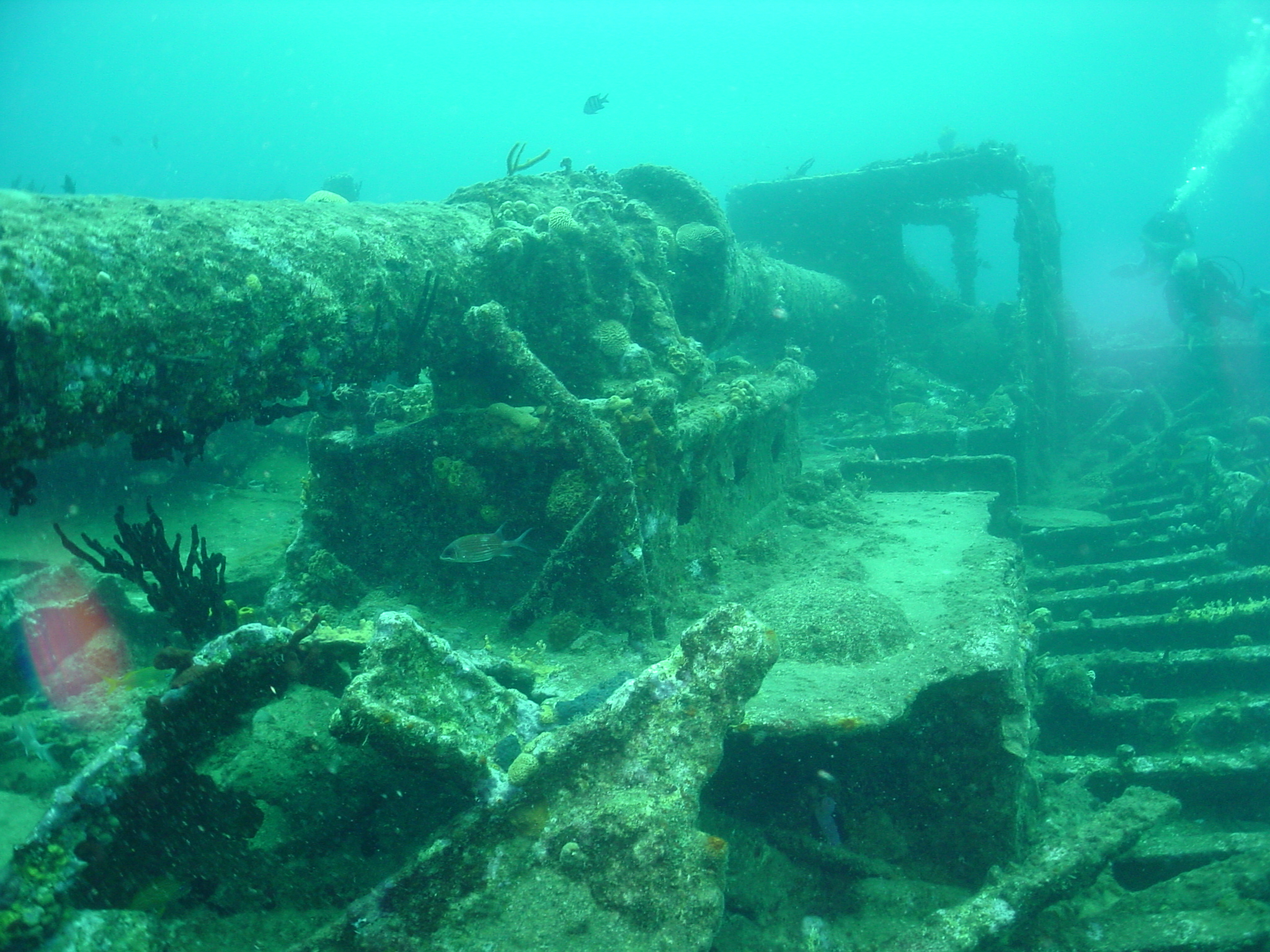
British Virgin Islands: R.M.S. Rhone
The R.M.S. Rhone is a unique dive with a cool story to accomodate. The stories say that Captain Woolley steered his ship into the eye of a hurricane in 1867 and celebrated his success but the hurricane caught up and led the ship to crash tearing it into two parts. Many have said that you can still hear the screams of the crew members trying to escape the ship. If you want the complete experience it’s best to do this in two dives, explore the stern in one dive and the bow in another.
Fun Fact: This is where they filmed the 1977 movie The Deep
Avg. Water Temp: 80ºF (26.7ºC)
Avg. Visibility: 40-100 ft (12-30 m)
Avg. Depth: 35-80 ft (10.7-24 m)
Image from Wikipedia
South America
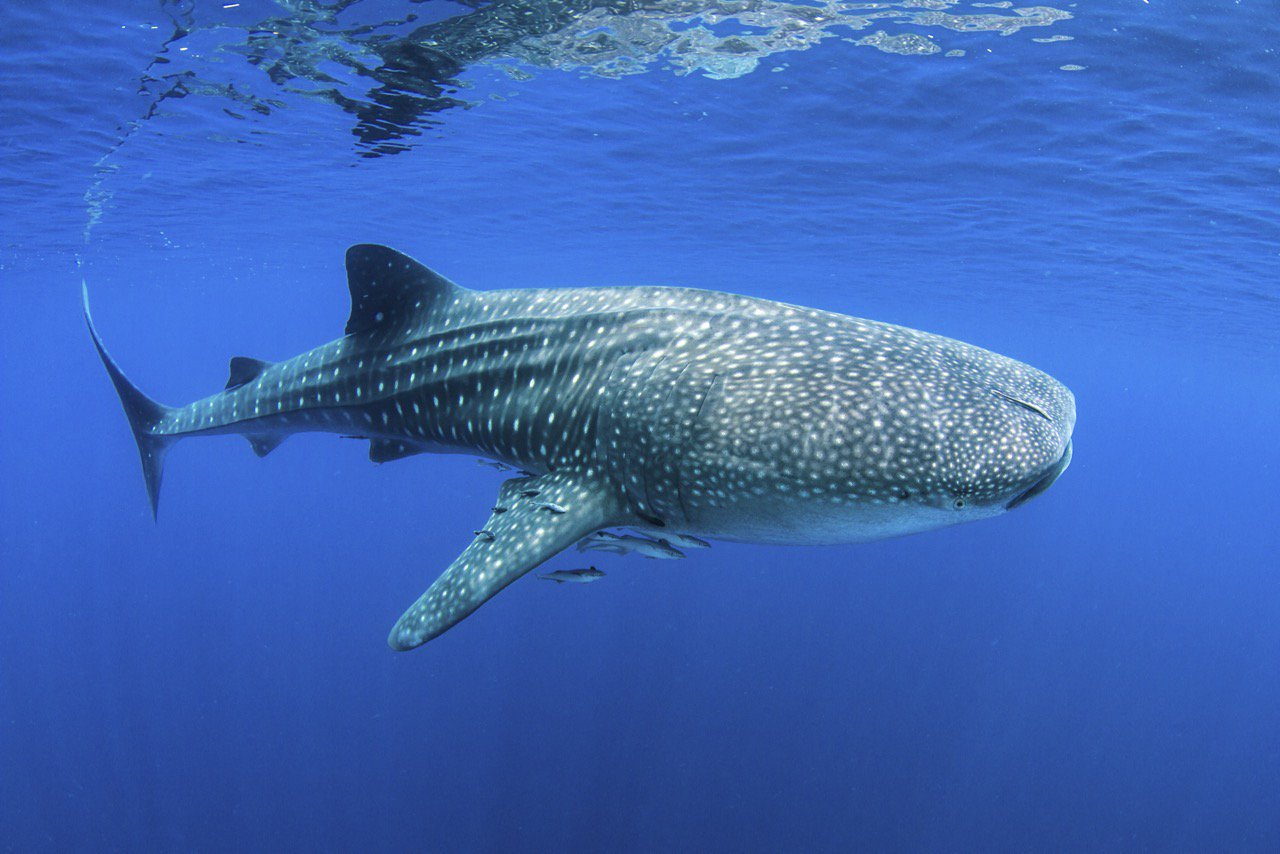
Mexico: Afuera
This is a snorkel-only site but you’re not missing out because Isla Mujeres is known for having the largest aggregation of whale sharks, and you don’t need to scuba dive to see those. A special species of fish called little tunny can be found here and one fish can produce up to 1.75 million eggs which is what attracts the whale sharks. Nearby you can also discover some stunning shallow reefs like the Mesoamerican Barrier Reef (the largest barrier reef in the Western Hemisphere) and the Atlantis Reef. If you’re not tired of snorkeling yet you can also explore the Machones Reef that is famous for its 500 underwater sculptures created by environmentalist and underwater photographer Jason deCaires Taylor. These reefs are home to many species including bottlenose dolphins, manta rays, barracuda, tawny nurse sharks, fish, moray eels, and Nassau groupers.
Avg. Water Temp: 82ºF (27.8ºC)
Avg. Visibility: 20-100 ft (6-30 m)
Avg. Depth: 100 ft (30 m)
Image from PADI Travel
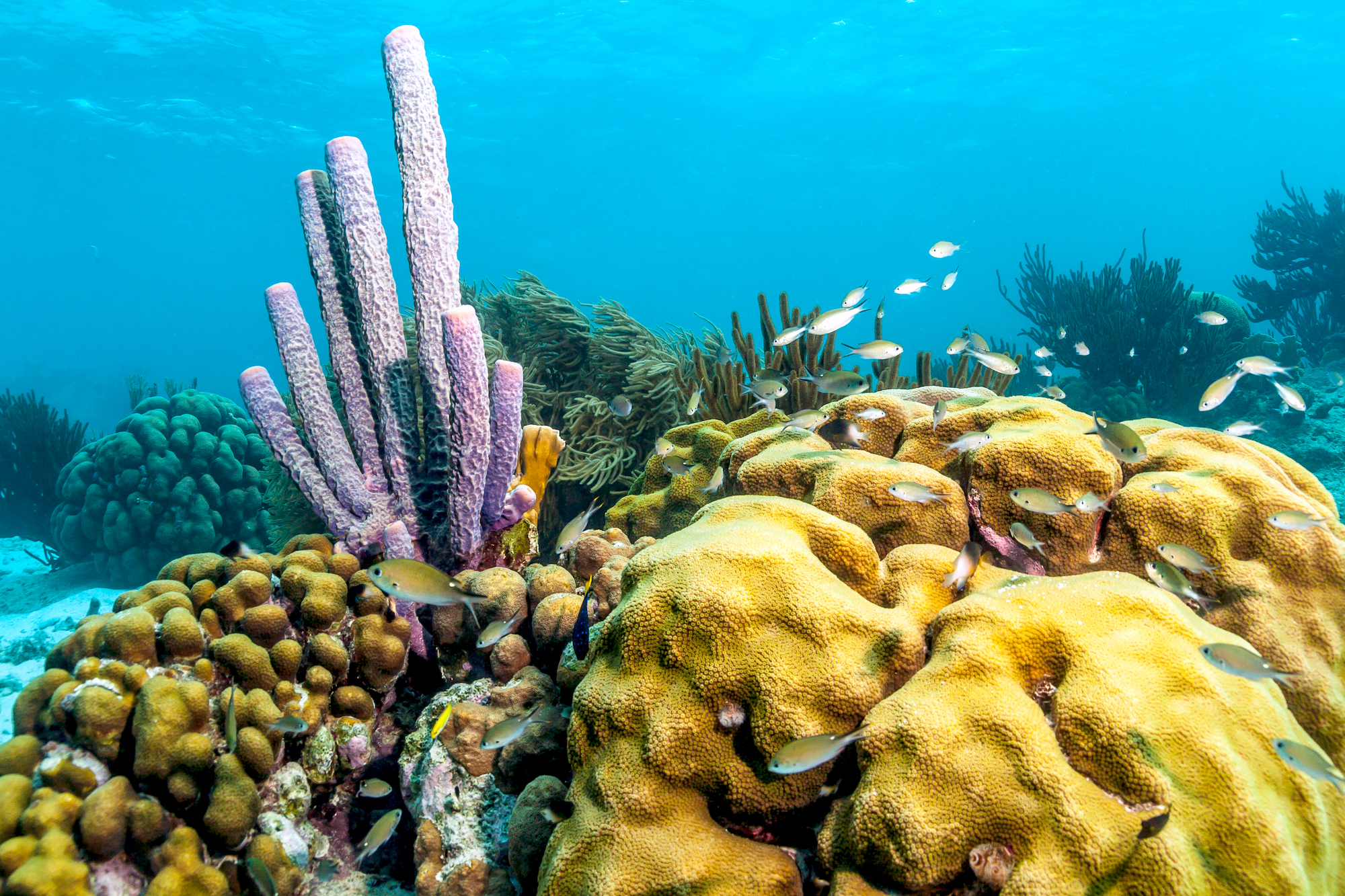
Bonaire: Something Special
Bonaire has over 100 dive sites in their marine park that are accessible to anyone, but there is a fee and orientation beforehand explaining rules, regulations, and restrictions. Something Special is one of the protected sites but it is definitely worth going to dive there because you’ll see tons of marine life of all shapes and sizes. The sites have dives for all levels including wrecks, reefs, walls, and drop-offs. Something Special is a stunning place to dive and it really lives up to its name.
Avg. Water Temp: 80ºF (26.7ºC)
Avg. Visibility: 75 ft (22.9 m)
Avg. Depth: 50 ft (15 m)
Image from PADI Blog

Mexico: Discovery Bay
Located on the island of Guadalupe, the Discovery Bay dive is home to many species including fur seals and tuna that attract hundreds of great white sharks every year. The site offers cage diving for those daring enough to descend into great white shark infested waters making this one of the most unique dives you could experience. The dive is only accessible by boat though, meaning that it is a liveaboard experience that lasts a couple days. So make sure you come prepared for that!
Avg. Water Temp: 68ºF (20ºC)
Avg. Visibility: 125 ft (38 m)
Avg. Depth: 33 ft (10 m)
Image from Scuba Adventures
Africa
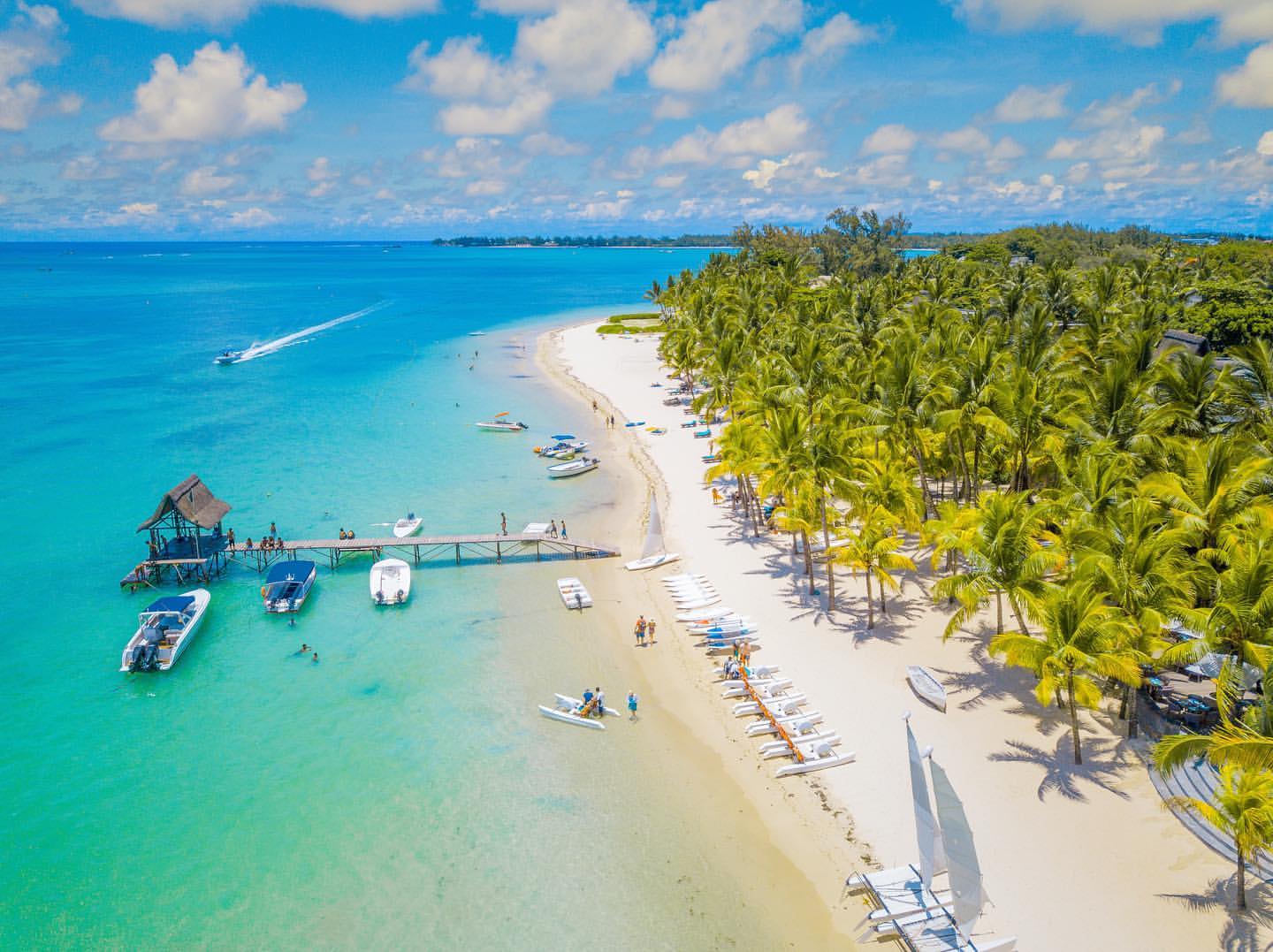
Mauritius: Trou Aux Biches
Located in the Indian Ocean, Mauritius is a small island with a lot to see. There’s a lagoon, reefs, wrecks, and caves and caverns. You can dive with schools of fish that come in all colors and between some magnificient natural coral structures. There are a couple easily accessible dive sites around the area that make it perfect for divers of all levels. You might even get the chance to swim with some of the oceans most fascinating creatures, stingrays.
Avg. Water Temp: 78ºF (25.6ºC)
Avg. Visibility: 50 ft (15 m)
Avg. Depth: 23-130 ft (7-39.6 m)
Image from Sejour Maurice
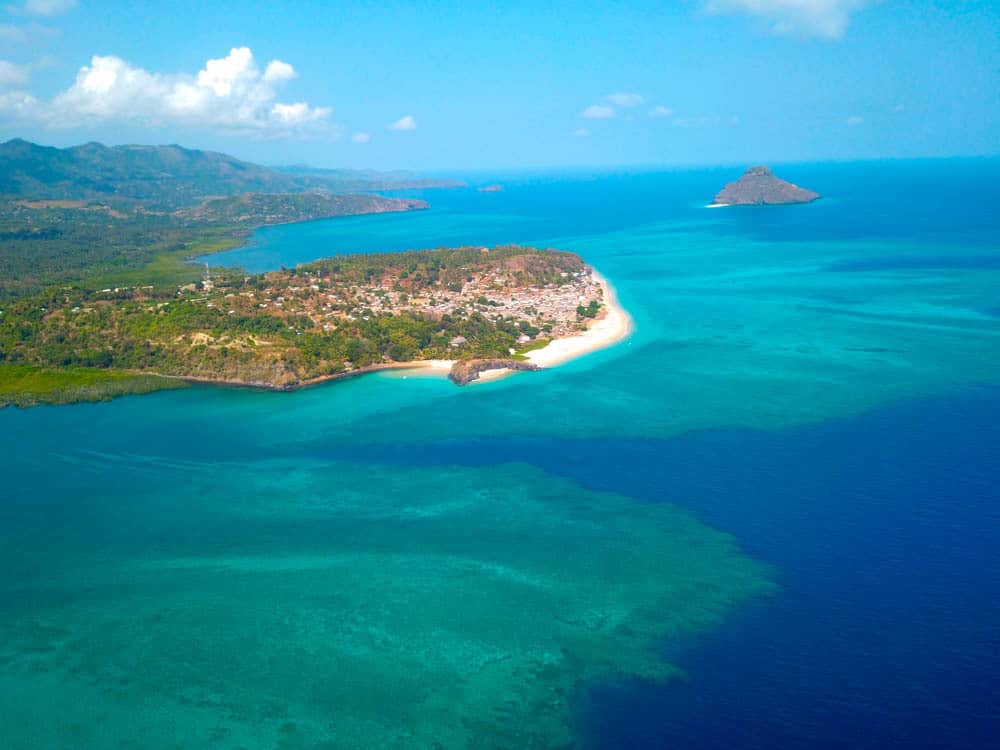
Comoros: Mohéli Marine Park
Comoros is a very poor country with very little pollution making tourism one of its main sources of income. This means that you should know what you’re walking into before getting there and you should come prepared.
The Mohéli Marine Park spans about 155 square miles and is teeming with life. Coral reefs and sandbanks are home to fish, sharks, rays, and turtles. But the area is still very much unexplored, leaving us unaware of the many fascinating things that must roam below the surface. One of the coolest things you could see while diving here is the coelacanth, which is a unique spotted fish with many fins.
Avg. Water Temp: 77ºF (25ºC)
Avg. Visibility: 75 ft (22.9 m)
Avg. Depth: 15-75 ft (4.6-22.9 m)
Image from Unusual Traveler
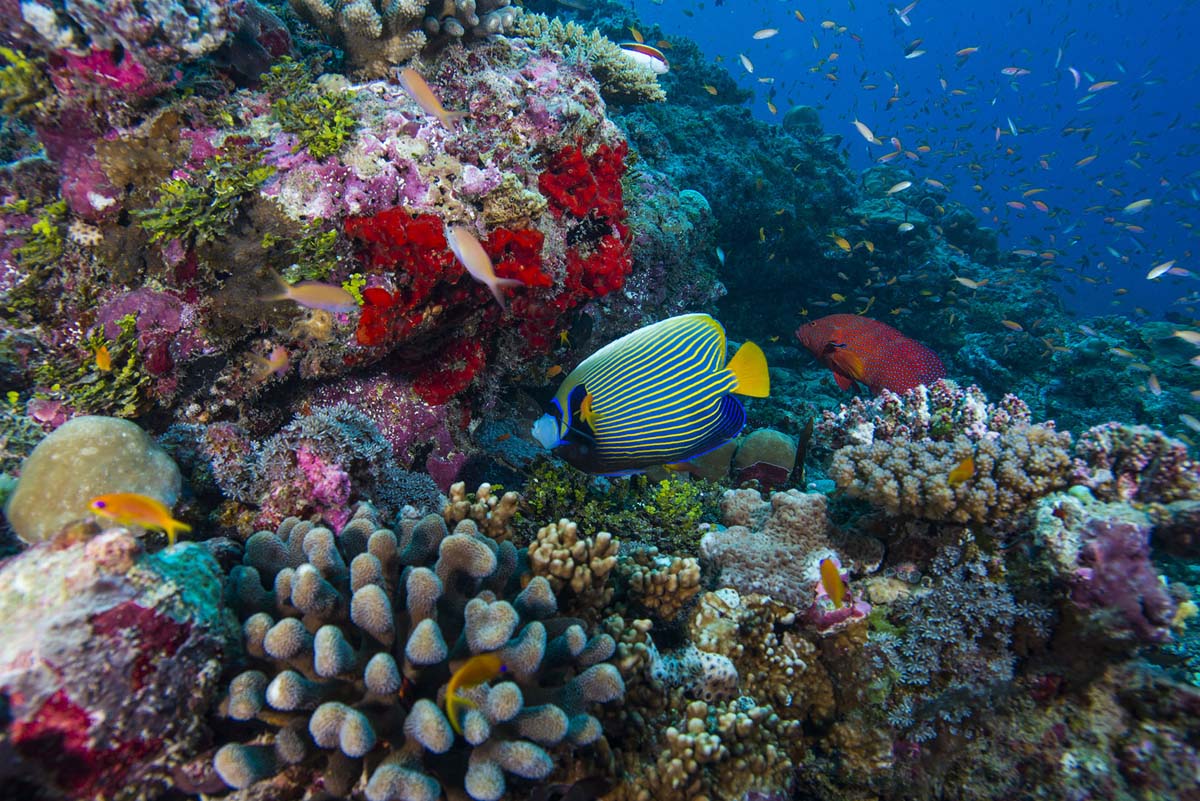
Seychelles: Alphonse Island
As one of those, now rare, places, the islands that make up the Seychelles archipelago are basically untouched. There isn’t a large population, there isn’t much fishing, and people are careful to preserve the beauty of such a place. With many, many dive sites along these islands, the Wonderland site is one of the well known ones because of its diversity in such shallow waters. There are so many things to see, from turtles and sharks to fish, eels, and lobsters, you’ll be able to navigate the colorful reefs and rocks too. It’s truly a site to see. Other fun sites to explore include Turtle Parade and House Reef that also have hundreds of species roaming beneath the surface.
We are lucky that places like this still exist today, so don’t miss your chance on going to dive here. And if you do happen to visit Seychelles and its mesmerizing turquoise waters, respect the environment, please!
Avg. Water Temp: 84ºF (28.9ºC)
Avg. Visibility: 50-100 ft (15-30m)
Avg. Depth: 10-130 ft (3-39.6 m)
Image from Alphonse Island
Canary Islands: El Bajon Del Rio
The El Bajon Del Rio dive site is quite unique. This site is composed of volcanic rock structures that form mushroom shapes, caves, caverns, and more. The entire site is filled with hundreds of colors due to the many species that roam the site all day and night. The sandy bottom is home to stingrays, while the caves are where the eels live. The corals, algae, and sponge that grow on the volcanic rock bring zebra, cow, and blacktail fish to the area. There’s so much to see and it’s such an easy dive (when conditions are right), that most divers stay on the Canary Islands a couple of days to be able to dive here multiple times.
Avg. Water Temp: 70ºF (21ºC)
Avg. Visibility: 32-100 ft (9.8-30m)
Avg. Depth: 53 ft (16.2 m)
Image from Alphonse Island
